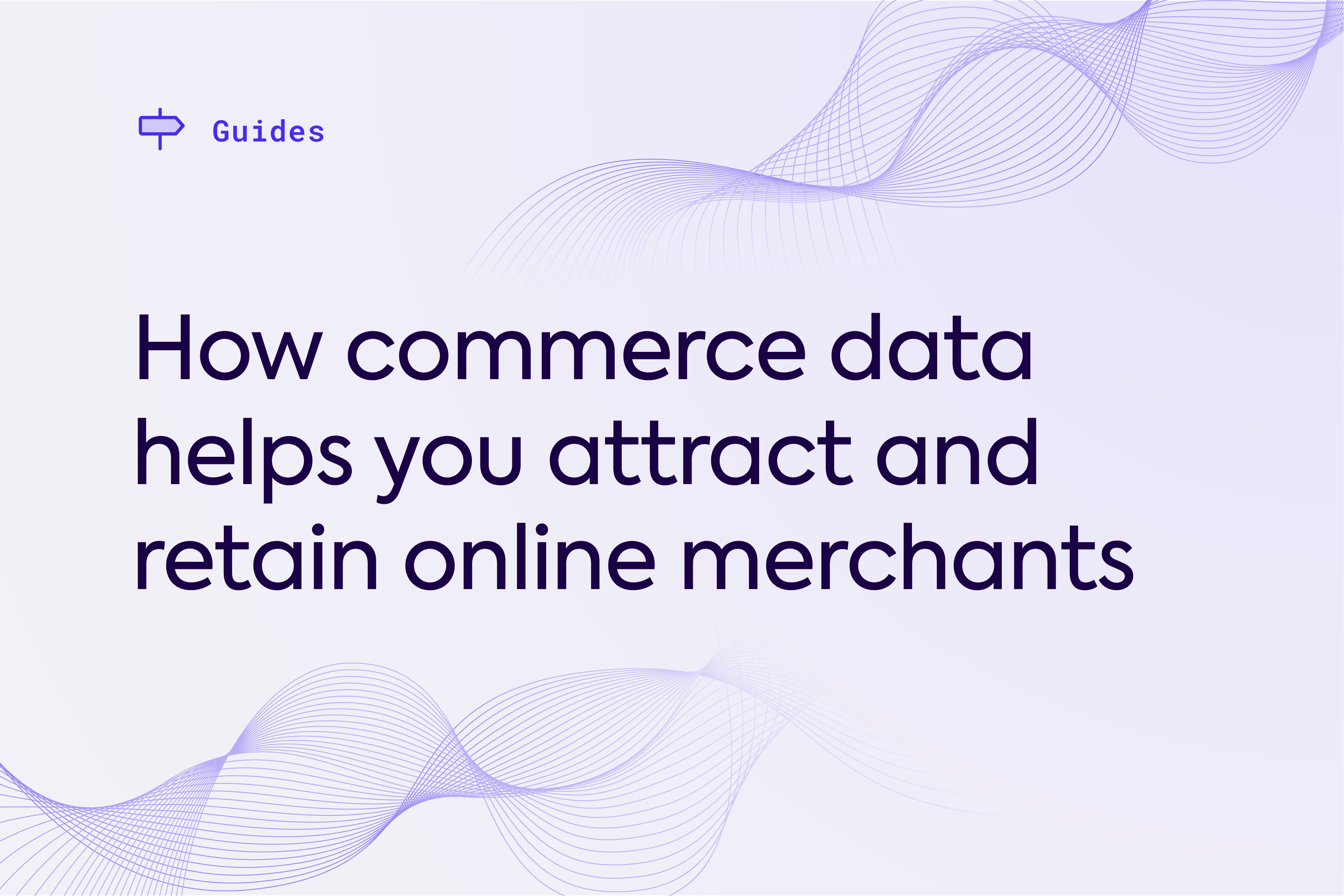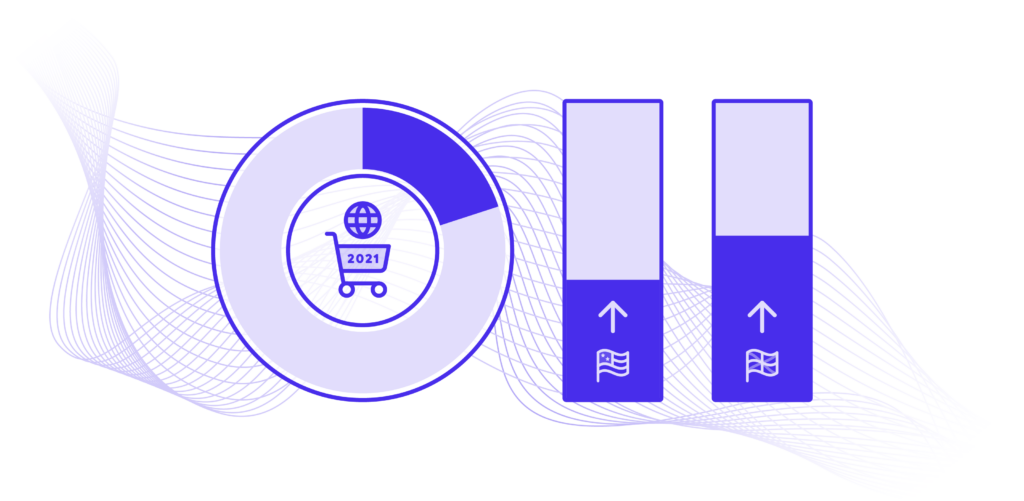
Win over eCommerce businesses by providing the services they really need.
In 2021, eCommerce sales accounted for almost 20 percent of retail sales worldwide, making it one of the fastest-growing industries. This marks an increase of 40 percent in the US and 55 percent in the UK.
To make the most of this surge and win the business and loyalty of thriving online retailers, eCommerce service providers, from software solutions to financial institutions, are increasingly extending their offerings and seeking out ways to add interoperability to their product. For eCommerce service providers in the know, that includes leveraging commerce data.

Commerce data is a rich data set that includes orders, payments and refunds, disputes, transactions, product inventory and pricing, and more. Providers can access commerce data via proprietary or outsourced integrations with platforms eCommerce businesses already use to do business, like payment platforms, point of sale terminals like Square, and online marketplaces like Etsy.
The value of commerce data lies in the products, services, and features it potentiates—things like workflow and reconciliation automation, deep business intelligence insights, holistic underwriting, and seamless user experiences.
In this blog post, we discuss just some of the ways eCommerce service providers can use commerce data to optimize their offerings and grow their online merchant customer base, including
- Revenue-based lending
- Accounting
- Carbon accounting
- Dashboarding
- Shipping solutions
- Customer loyalty and rewards programs
Revenue-based lending
“By leveraging commerce data, lenders are able to offer a fully-realized digital experience.”
The eCommerce industry is dynamic, competitive, and fast-paced. In order to keep up, many online merchants need to accelerate their growth by way of funding and loans. But the application process for traditional loans often requires time-consuming documentation. And by not incorporating commerce data, the process might not provide the most accurate insights into a company’s overall performance, leaving lenders at increased risk that makes them less likely to offer favorable loan terms.
By bolstering accounting data with commerce data, lenders can:
- Offer targeted loans for specific segments of a business, such as an inventory loan that allows a customer to restock popular items.
- Pull in and compare information like payments, transactions, orders, and disputes to identify red flags and formulate a more accurate risk profile.
By pulling in data which is most relevant to eCommerce businesses—such as product info, orders, and payments data—from the platforms and marketplaces they use every day, lenders get a sense of how well a business is performing and get a better view of their merchant customers’ creditworthiness.

For example, if a merchant’s sales are high, but disputes are also high, a lender leveraging commerce data can see how the rate of chargebacks are affecting the business’s bottom line.
This results in benefits for merchants themselves, including:
- Quicker pre-qualification processes
- More personalized loans that can ease constraints on cash flow.
- More flexible loan terms.
By leveraging commerce data, lenders are thus able to offer a fully realized digital experience—one that results in reduced risk, faster funding, and better loan terms for merchants. With continued access to commerce data, lenders can also provide better service to their merchant customers by proactively extending lines of credit and offering other assistance in the long run.
The use of commerce data can also help digital-first institutions like neobanks differentiate themselves by offering services like instant payouts.
For merchants who sell on marketplaces like Amazon, purchases aren’t paid out immediately. But when neobanks have access to payment data, they can see which payouts are pending and offer customers an instant advance for the expected amount—alleviating cash flow issues and helping their customers grow. Meanwhile, for the neobank, instant payouts foster customer loyalty and retention and generally stickier relationships, potentially driving assets under management.
Commerce integrations for accounting platforms
“Manually syncing commerce data can cause costly reconciliation headaches.”
Accounting platforms would also be wise to leverage the power of commerce data to add value to their customer relationships.
With a massive volume of transactions taking place, manually syncing commerce data with a separate accounting system is not only a complicated, time-consuming task; it’s also prone to human data entry errors that cause costly reconciliation headaches.
Further complicating accounting matters is the issue of sales tax. When online merchants have inventory in multiple locations, they are subject to the sales tax policies for each of those areas and face heavy penalties if they don’t abide. To be compliant, they have to keep track of where their inventory is stocked, what states they do business in, and what the sales tax policies are for each.
By integrating with commerce data sources, accounting platforms can alleviate these issues. Having a steady stream of commerce data allows accounting platforms to:
- Automate data reconciliation between customers’ books and their bank statements.
- Automatically apply sales tax across multiple locations to ensure compliance with area-specific tax policies.
- Keep track of purchase orders.
- Provide a more accurate valuation of inventory.
Features like the above make for a product that wins customer loyalty and supports customer retention.

Carbon accounting solutions
“Commerce data can be used to automate emissions calculations and build a more complete picture of a business’s carbon footprint.”
As countries around the world grapple with the challenges posed by climate change, new business regulations are being drafted to better address these issues. At the same time, we are witnessing a rise in environmentally conscious consumers, which means that carbon accounting services will be very much in demand in the coming years.
Carbon accounting is the practice of using accounting data to assess how sustainable a business is. By pulling in commerce data—specifically, as it relates to inventory and shipping—into your accounting solution, you gain important insights like:
- Where stock is stored.
- How stock will be transported.
- The weight of stock.
This data can then be used to automate emissions calculations and provide them to online merchants, building a more complete picture of their carbon footprint. The merchants can then use this information in a variety of ways such as:
- Proving the eco-friendliness of their brand.
- Creating carbon offset programs.
- Providing their customers with eco-friendly shipping or packing options.
These efforts can help raise their standing and keep them compliant as new regulations emerge.
Dashboard visualization
“By aggregating commerce data, dashboard visualizations can offer a more exceptional breadth and depth of business intelligence.”
In order to run their business successfully, online merchants need to keep track of a variety of metrics. Dashboards built off of just traditional accounting data aren’t granular enough, requiring merchants to access a number of disparate systems to view the information they need. It’s a piecemeal stopgap at best.
To stand out from the status quo, fintechs and dashboarding apps offering a finance management dashboard feature shouldn’t limit their integrations to accounting. By aggregating commerce data, dashboard visualizations can offer a more exceptional breadth and depth of business intelligence insights such as:
- Cash flow forecasting.
- Number of orders.
- Revenue.
- New customers.
Having at-a-glance access to metrics like these, all in one place and in real-time, is a value-add that drives customer engagement and makes for a sticker product.
Shipping
“Commerce data can help online merchants save money by making the shipping process more efficient.”
Shipping is the lifeblood of the commerce industry. But if it’s not managed correctly, it can become a major expense. That’s because the shipping process is a complex one to execute efficiently. Online merchants have to arrange for products to be packaged at appropriate facilities and print shipping labels for each item sold. When we factor in returns, things can get even trickier, and costs can quickly add up.
It’s only logical that these kinds of businesses would benefit from shipping software that pulls in their commerce data—specifically inventory, purchase, and customer endpoints—and uses it to optimize the fulfillment of their orders. The benefits of commerce data sync include the ability to:
- Access “live” rates and calculate costs in real-time.
- Pre-populate information fields like package size and weight to save time and ensure accuracy.
- Provide an overview of critical information like transit times, packaging options, and international rates and zones to optimize shipping strategies.
And while the above applications of commerce data might seem basic, their impact is anything but, as they help online merchants save money by making the shipping process more efficient.
Loyalty points and rewards programs
“Commerce-based insights help boost retention among eCommerce customers.”
Another useful application of commerce data is using it to offer more integrated rewards programs for online merchants.
Because the eCommerce market can be so competitive—with better deals often just a click away—boosting retention rates is a major part of running a successful eCommerce business. By tracking commerce data like purchase history and customer activity, loyalty program providers can offer online merchants insight into their customers’ behaviors and help them optimize their rewards programs to support repeat business and customer retention.
Some of the helpful insights commerce data unlocks are:
- Which returning customers are placing the most orders.
- Which customers are at risk of churning.
- The amount of time that passes between orders.
With these insights aggregated for them, online merchants can determine which customers need to be rewarded for their loyalty and what form those rewards should take. They can also try to re-engage customers that are dangerously close to churning.
How Codat helps you appeal to eCommerce businesses
Codat is committed to providing a variety of commerce integrations that help you give online merchants the solutions they need.
To go deeper on the opportunities commerce data presents, you can download our comprehensive report here. If you’re interested in learning more about what it takes to build and maintain commerce integrations at scale, check out our how-to guide.